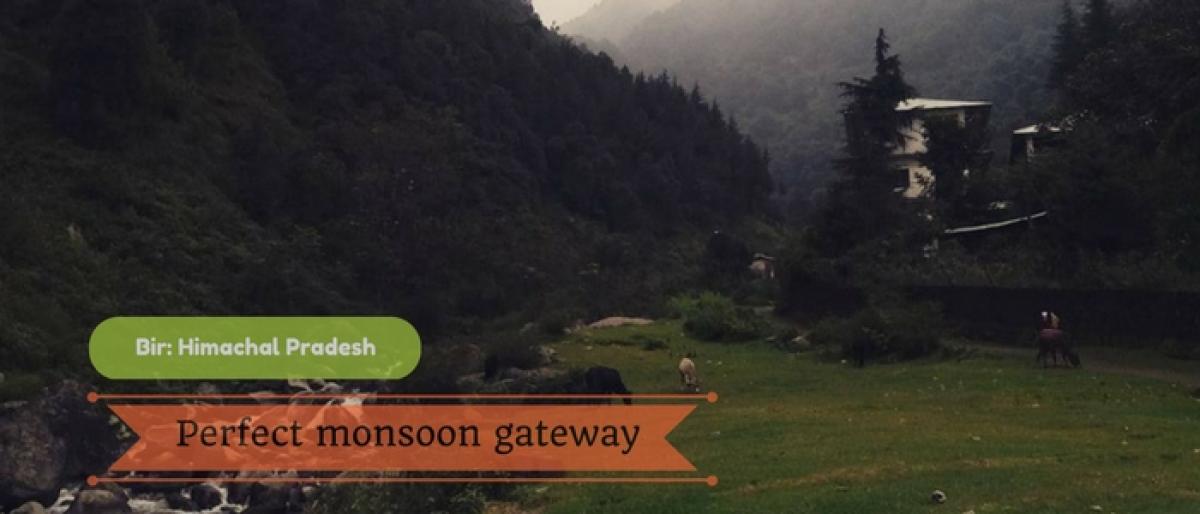Live
- GMR Airports Unveils AI-Powered Digital Twin Platform to Transform Airport Operations
- India poised to become leading maritime player: PM Modi
- Top Causes of Kidney Stones and How to Recognize Silent Symptoms
- India’s renewable energy capacity logs 14.2 pc growth at 213.7 GW
- Winter Session of Odisha Assembly adjourned sine die
- Biden calls Trump's tariff approach 'major mistake'
- After Drama Over Eknath Shinde’s Chief Minister Race, Maharashtra Cabinet Formation Faces New Tensions
- Egyptian FM, Blinken discuss recent developments in Syria
- Iran's supreme leader says Syria's developments result of US-Israeli 'plot'
- Elon Musk to Purchase $100 Million Luxury Mansion Next to Donald Trump's Mar-a-Lago, Report Reveals
Just In

Imagine a morning like this -- pull aside the window curtains to witness the magnificent snow-capped Dhauladhar range standing tall and the surrounding hilltops covered by dark clouds; suddenly it starts pouring heavily, rain drops sprinkling your face as you sip your morning cuppa.
Bir -- a tiny, pristine Tibetan refugee village located in Kangra district of Himachal Pradesh at an altitude of 5,003 feet is a perfect monsoon gateway from mundane urban life
Imagine a morning like this -- pull aside the window curtains to witness the magnificent snow-capped Dhauladhar range standing tall and the surrounding hilltops covered by dark clouds; suddenly it starts pouring heavily, rain drops sprinkling your face as you sip your morning cuppa.
Well, this is how I was greeted in Bir -- a tiny, pristine Tibetan refugee village located in Kangra district of Himachal Pradesh at an altitude of 5,003 feet, my monsoon gateway from mundane urban life.
The best part of monsoon travel remains watching it rain in the hills. It was dawn when I entered the Kangra valley and I could hear the rain drops slamming against the bus window. With drowsy eyes, I saw that the valley was wrapped in dense fog and clouds and it remained so till I reached Bir.
A breath of fresh air, carrying the smell of wet soil, welcomed me as I stepped into the Tibetan colony. The Buddhist flags were flapping as the cool breeze touched them and chants echoed from a nearby monastery.
Though incessant rain seemed to be in a mood to spoil my plans, it couldn't diminish my excitement. As I stepped out, I could feel a calmness in the air which was soothing and blissful. The curvy roads were ornamented with fallen maple leaves.
The cool wind would pierce through the pine and spruce trees which carried a rapturous tune of rustling leaves accompanied by the chirping of birds.
Not just an abode of natural beauty, Bir is also a place known for its monasteries -- five within the village. With its unique architectural style and beautiful paintings, each monastery is a must-visit. Also, worth visiting is PalpungSherbling monastery that is 11 km from Bir.
It will be an injustice if I don't talk about the mouth-watering food that Bir offers. The village is a paradise for those with a penchant for Tibetan food and can do without fancy restaurants. There are many eateries, mostly run by locals, that serve authentic, home-made Tibetan cuisine.
Grab a piping hot mutton dumpling or enjoy a spoonful of Thenthuk -- soup made of various vegetables and noodles. Opt for Tingmo -- a type of steamed bun -- with any main course instead of rice or noodles, and engulf yourself in the heavenly bliss of the delicacies. So, before the monsoon bids adieu, head to Bir.
Time taken from Delhi to Bir -- about 12 hours.
How to travel: Buses run on daily basis from Kashmere Gate ISBT. One can take a cab from Palampur or Baijnathwhich will charge around Rs 350 to Rs 250 respectively.
Where to stay: There are many hotels at reasonable rates (off season travel can get one a good hill-facing room for Rs 500 or even less).
Best time to travel: Avoid the monsoon if travelling for paragliding, else Bir is comfortable through the year.

© 2024 Hyderabad Media House Limited/The Hans India. All rights reserved. Powered by hocalwire.com







